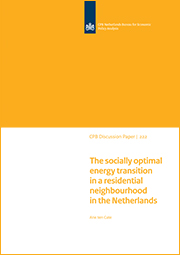The socially optimal energy transition in a residential neighbourhood in the Netherlands
Energiebelasting verstoort verwarmingskeuze Nederlandse huishoudens

We are sorry, unfortunately there is no English translation of this page.
The coming energy transition in residential neighbourhoods in the Netherlands is the result of the increasing cost of CO2 emission and the decreasing costs of solar PhotoVoltaics (PV) and alternative techniques of residential heating, namely Combined Heat and Power (CHP) and heat pump.
The optimal transition is found by minimizing the total discounted social costs of residential energy consumption and generation. Social costs include the cost of CO2 emission and the investment in the electric network. The model integrates economics and the electric constraints based on the Alternating Current (AC) network power flow.
The results indicate that in the optimal transition nearly all houses are going to use an air-to-water heat pump with auxiliary gas heating. This shift from gas to electricity depends very little on the future CO2 price or the network costs. Solar PV is not yet socially profitable at this moment.
The "business case" for a household, using private costs, includes taxes and excludes CO2 costs and uses a higher discount rate. In the resulting optimum no heat pumps are used. However, reducing the ratio of the electricity tax versus the gas tax moves the private optimum to the social optimum.
In order to use the model (with GAMS) or to verify table 18 (with Octave/Matlab), download the packed file below (If needed: rename it from .txt to .zip and unpack the file).
After the publication, the following problem was noted by a reader. According to section 5.3, first paragraph, the heat pump is socially optimal in the old neighbourhood. However, in general this is somewhat unrealistic: the heat pump has a low water temperature, requiring enlarging the capacity of the radiators.
Also, "starting at 20 euro" at page 11 is simply the actual value up to 2010.
